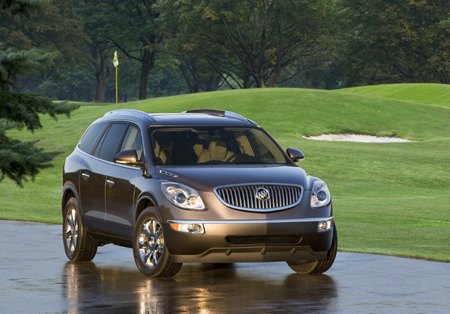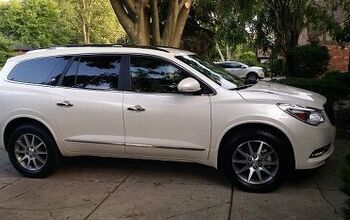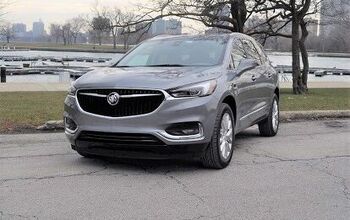2007 Buick Enclave Review
When better cars are built, Buick will build them. Meanwhile, they’re building CUV’s. Huh? An automotive brand whose lack of identity has kept it on life support for well over a decade wants a piece of a vehicular genre that’s a little bit of this, a little bit of that, and nothing in particular. GM’s willingness– make that “eagerness”– to throw Buick a CUV-shaped, badge-engineered bone demonstrates the corporate mothership’s abject and ongoing inability to devise a coherent plan to resuscitate its “damaged” (i.e. terminal) Buick brand. What is it with these guys?
Anyway, calling a vehicle of the Enclave’s epic dimensions a crossover forces us to expand the genre’s definition from “cute ute” to “the bastard child of a minivan and a full-sized SUV.” That said, Buick's CUV on steroids is a surprisingly graceful design. Well-judged chrome accents abound, from the door trim to the blinged-out wheels. The premium paint job is worth the extra cash; a pearl-coated Enclave’s spizzarkle will make Cadillac owners scowl into their prune juice.
The purpose of these porky proportions lies within. Much like Danielewski’s house of blue, the Enclave is bigger on the inside than on the outside. Sliding second row seats can provide as much or as little rear space as needed, depending on the degree of family bonding desired. Optional middle-row bench seats up the capacity to eight, for maximum character building. And accoutrements abound, giving backseat drivers their choices of entertainment and environmental controls.
Though I applaud GM’s brave decision to hire the blind to color-match the Enclave’s interior, the model’s beige leather, floor and ceiling clash with the ashy brown door trim; which is irritatingly beset with medium-shaded wood accents. The plastics are alternately hard and soft– softer where contact is inevitable and harder where only masochists dare to tread (especially after initial, revulsion-inducing contact).
Brushed metal trim on the door handles add (ADD?) to the boggle factor. The dash provides a similar lack of coherence; chrome strips and an analog clock top off the WTF factor. Wood also makes a guest appearance on the steering wheel, playing the role of the suave but untrustworthy stranger. Note to Buick: wood or metal, pick a side.
The number of dashboard controls never reaches the sheer distraction level of an MDX, but it’s not for lack of trying. After a brief tussle with the Enclave’s electronic seating controls, during which the memory function attempted to crush my kneecaps, we were on the road.
After driving a selection of super-sized SUVs, I squared off for battle with yon steering wheel, only to find it surprisingly light and responsive. The closet enthusiast may be disgusted by the lack of road feel and steering feedback, but then, they’re not likely to purchase something of these epic proportions. The average luxobarge driver will appreciate the Enclave's easy, quick steering and wonderfully cushy suspension.
In fact, you can easily forget you’re piloting a 2.5 ton vehicle– until you attempt brisk acceleration. With its V6 kicking-out 275hp and 251 ft.-lbs. of torque, the Enclave literally lags behind its natural rivals. Zero to sixty takes 8.4 seconds; the Acura MDX gets the job done in 7.2 and the Mazda CX-9 arrives in 7.5.
The Enclave’s six-speed automatic transmission is a step ahead of standard GM fare, but the gearbox serves-up early upshifts and late downshifts, with a heavy side of throttle lag. You can take matters into your own hands with shift lever-mounted buttons, but chances are you won’t.
The Enclave comes complete with airbags for all and the usual alphabet stew of safety equipment: ABS, TPMS, ESC and Anti-Rollover Logic (if your common sense fails). Nav-equipped vehicles offer a rear view camera, a handy option in a car with this much bounteous booty.
The $33k-ish (and up) front wheel-drive Enclave offers a considerable amount of value for driver who can appreciate the subtle luxuries within. Actually, “near luxury” pretty much nails it. For significantly less money than its foreign luxury competitors, you can buy a Buick Enclave and pretend you’re driving a mid- to large-sized luxury SUV– without the handling, performance or reputation.
Alternatively, for a few thousand dollars less, you can buy either one of the Enclave’s non-identical twins: the Saturn Outlook or GMC Acadia. Or wait for the Chevy version. Or just wonder why GM builds better Buicks in China, and then sells four versions of the same CUV in America, reserving the best looking one for their doomed division, without giving it a proper V8 to distinguish it from its automotive homonyms.
I'm a computer security geek raised in Nebraska and recently transplanted to Atlanta. I like me some cars, got into car geekery a few years ago and haven't looked back since. I also volunteer at a local ferret shelter and participate in various charity and fund-raising events related to that.
More by Megan Benoit
Latest Car Reviews
Read moreLatest Product Reviews
Read moreRecent Comments
- Jalop1991 In a manner similar to PHEV being the correct answer, I declare RPVs to be the correct answer here.We're doing it with certain aircraft; why not with cars on the ground, using hardware and tools like Telsa's "FSD" or GM's "SuperCruise" as the base?Take the local Uber driver out of the car, and put him in a professional centralized environment from where he drives me around. The system and the individual car can have awareness as well as gates, but he's responsible for the driving.Put the tech into my car, and let me buy it as needed. I need someone else to drive me home; hit the button and voila, I've hired a driver for the moment. I don't want to drive 11 hours to my vacation spot; hire the remote pilot for that. When I get there, I have my car and he's still at his normal location, piloting cars for other people.The system would allow for driver rest period, like what's required for truckers, so I might end up with multiple people driving me to the coast. I don't care. And they don't have to be physically with me, therefore they can be way cheaper.Charge taxi-type per-mile rates. For long drives, offer per-trip rates. Offer subscriptions, including miles/hours. Whatever.(And for grins, dress the remote pilots all as Johnnie.)Start this out with big rigs. Take the trucker away from the long haul driving, and let him be there for emergencies and the short haul parts of the trip.And in a manner similar to PHEVs being discredited, I fully expect to be razzed for this brilliant idea (not unlike how Alan Kay wasn't recognized until many many years later for his Dynabook vision).
- B-BodyBuick84 Not afraid of AV's as I highly doubt they will ever be %100 viable for our roads. Stop-and-go downtown city or rush hour highway traffic? I can see that, but otherwise there's simply too many variables. Bad weather conditions, faded road lines or markings, reflective surfaces with glare, etc. There's also the issue of cultural norms. About a decade ago there was actually an online test called 'The Morality Machine' one could do online where you were in control of an AV and choose what action to take when a crash was inevitable. I think something like 2.5 million people across the world participated? For example, do you hit and most likely kill the elderly couple strolling across the crosswalk or crash the vehicle into a cement barrier and almost certainly cause the death of the vehicle occupants? What if it's a parent and child? In N. America 98% of people choose to hit the elderly couple and save themselves while in Asia, the exact opposite happened where 98% choose to hit the parent and child. Why? Cultural differences. Asia puts a lot of emphasis on respecting their elderly while N. America has a culture of 'save/ protect the children'. Are these AV's going to respect that culture? Is a VW Jetta or Buick Envision AV going to have different programming depending on whether it's sold in Canada or Taiwan? how's that going to effect legislation and legal battles when a crash inevitibly does happen? These are the true barriers to mass AV adoption, and in the 10 years since that test came out, there has been zero answers or progress on this matter. So no, I'm not afraid of AV's simply because with the exception of a few specific situations, most avenues are going to prove to be a dead-end for automakers.
- Mike Bradley Autonomous cars were developed in Silicon Valley. For new products there, the standard business plan is to put a barely-functioning product on the market right away and wait for the early-adopter customers to find the flaws. That's exactly what's happened. Detroit's plan is pretty much the opposite, but Detroit isn't developing this product. That's why dealers, for instance, haven't been trained in the cars.
- Dartman https://apnews.com/article/artificial-intelligence-fighter-jets-air-force-6a1100c96a73ca9b7f41cbd6a2753fdaAutonomous/Ai is here now. The question is implementation and acceptance.
- FreedMike If Dodge were smart - and I don't think they are - they'd spend their money refreshing and reworking the Durango (which I think is entering model year 3,221), versus going down the same "stuff 'em full of motor and give 'em cool new paint options" path. That's the approach they used with the Charger and Challenger, and both those models are dead. The Durango is still a strong product in a strong market; why not keep it fresher?
























![Buick Enclave Review [Take Two]](https://cdn-fastly.thetruthaboutcars.com/media/2022/07/20/9498320/buick-enclave-review-take-two.jpg?size=350x220)














Comments
Join the conversation
Dear Megan, While I applaud you for your entertaining, creative review I must let you know that I was confused after reading your comments and then test driving the Enclave. I am an early 30's guy that is deciding between the Q7, the Enclave, and the Lexus GX470. After reading your review I pictured the Enclave to be about the size of the MDX or the CX9 because your comment about these cars being natural rivals to the Enclave. After visiting a Buick dealership I was amazed at how much larger the Enclave was, in fact the only car that I have test driven to this date with similar dimensions and interior space is the Audi Q7, we are leaning away from the Lexus because of the 3rd row of seats being too small. The MDX and the CX9 are both too small for my purposes (family and cargo) but the Enclave being so much larger fits those needs nicely. I was also impressed with the options and the luxury of the vehicle even after driving the Q7 (especially since the Enclave is $15K less with comparable options and accessories.) It was so nice that I am really having a difficult time justifying the extra money for the Audi especially when reliability is factored in. I hope that other readers of this sight do not get the wrong impression about the Buick because it has this possible 30 year old Audi buyer leaning towards an American CUV...and a Buick to boot!
If acceleration were the weighted criteria this review may have helped ... to me it was roominess, comfort, hangling and quietness ... this car kicks butt over the competition in the above criteria ... competition is really the suburban or yukon xl in roominess and lexus 350 in ride and quietness ... this writer doesn't understand the market as well as GM this car and its sisters hit the mark ... CX-9 too cramped, noisier, rough ride and not as roomy ... same goes for MDX and its thousands more ... someone needs to help these reviewers understand were not all looking for a sports car some of us want an alternative for a minivan and the enclave wins.